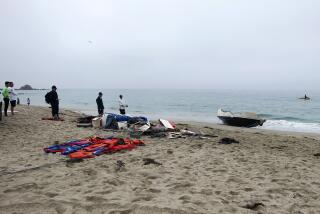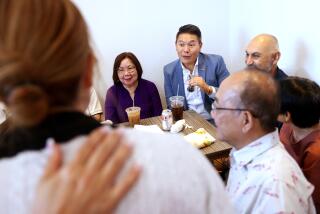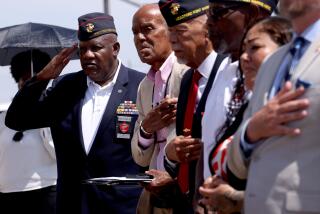Decades later, Vietnamese refugees honor Navy commander who rescued them
The temperature hovered around 100 under a blistering sun as the Navy cargo ship Robert E. Peary churned across the open sea off the coast of Malaysia.
When a lookout spotted a small fishing boat on the horizon, Bill Mathis — the naval vessel’s commander —ordered his crew to head in its direction.
It was 1979, four years after the fall of Saigon. But refugees were still fleeing Vietnam any way they could.
The rescuers found 448 people pressed into the 55-foot boat, some clinging to its rails. There was no food, no water — only a fleeting hope that the refugees might somehow make it to freedom.
Mathis’ determination to rescue those on board changed maritime law and established him as a hero in Little Saigon, the largest and best-known of the Vietnamese American enclaves that sprang up across the U.S. as immigrants arrived.
But until he was honored recently in Southern California, Mathis — a now-retired rear admiral who lives near Pensacola, Fla. — did not have a full understanding of his heroic reputation in a community so far from his own home.
Hundreds applauded him during an immigrant gathering, he was interviewed on Vietnamese television, and he was featured on “Paris By Night,” the long-running Vietnamese variety show.
At the gathering was My Lan To, who was 16 when crew members pulled her and her family aboard the Navy ship.
“Whatever you saw in the movies, we experienced much worse,” To said. “I cannot think of how it might have ended, if not for the admiral.”
Though it was decades ago, the memories came back quickly.
“I will not forget the terror of the victims,” Mathis said. “They were dehydrated, the heat and stench unbearable. There were two pregnant ladies and a 4-day-old baby born in transit. Four days old — can you imagine?”
To said she was convinced all of them would die.
A day after he first spotted the boat on May 6, 1979, Mathis said he still did not have clearance to rescue the refugees. U.S. relations abroad were strained, and he recalled government officials being “very leery of allowing unauthorized refugees into the U.S.” at a time when thousands were pouring out of Vietnam after the war.
Two days later, Mathis finally got approval — with orders to continue to Thailand, where his passengers would be handed over to a United Nations humanitarian assistance team. Still, as the refugees climbed aboard, he and his crew had to figure out how to keep them alive until they arrived.
Sailors rigged portable toilets and showers on the ship’s fantail and rationed water. Blankets from the bunks were spread across the rough surface of the helo deck as makeshift beds and a helicopter hangar were converted into a sick bay. Even the Christmas candy the crew had saved was passed out.
The passengers had endured far worse as they bobbed on their own tiny boat. Pirates had attacked the vessel repeatedly, taking their food and valuables, according to To and her cousin, fellow passenger Kiet To Snow. When there was nothing left to steal, the invaders raped some of the girls.
The sheer number of those rescued gained worldwide attention, and Congress that year made it mandatory for naval officers to “render assistance, aid and offer to embark” to any refugees a commanding officer deemed to be in a life-threatening situation.
“A mariner’s first obligation is to assist if people are in distress on the high seas,” said Mathis, 75.
Laurie Brown said she was still in high school when her father stepped off the ship, swarmed by reporters eager to learn more about the rescue.
“Like a lot of children of servicemen, I came to understand that what he did, he did for a love of his work,” Brown said. “For folks like him, it’s God, family, duty. It’s not something they brag about. My mom and I didn’t even realize it was a big deal.”
To said Mathis became a role model to her. She’s now a civilian project manager for the Navy’s littoral combat ships, agile, small-surface vessels that operate close to shore.
“He set an example of courage and dedication for the rest of us to follow,” To said.
Mathis said he’s overwhelmed by the affection.
“I never, ever thought the refugees would welcome me into their community and share an honor like this,” he said. “What I did was so simple. Many other people would have done the same thing.”
Twitter: @newsterrier
More to Read
Sign up for Essential California
The most important California stories and recommendations in your inbox every morning.
You may occasionally receive promotional content from the Los Angeles Times.











